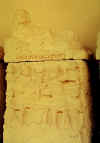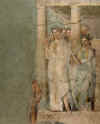Special Topics:
The Sacrifice of Iphigenia
the representations of the myth through art.
Lindsay Clary
Please click the thumbnail to see the larger image.
 This
is the only Ancient Greek rendition of the sacrifice I could find. The image of
a stag is superimposed on Iphigenia, mimicking other renditions of the myth
(than Aeschylus', that state Artemis replaces Iphigenia with a stag. Also,
note the tray of food or incense on the left, both first fruit rituals mentioned
by Burkert. This red-figured on black pottery is from the 5th century BCE.
This
is the only Ancient Greek rendition of the sacrifice I could find. The image of
a stag is superimposed on Iphigenia, mimicking other renditions of the myth
(than Aeschylus', that state Artemis replaces Iphigenia with a stag. Also,
note the tray of food or incense on the left, both first fruit rituals mentioned
by Burkert. This red-figured on black pottery is from the 5th century BCE.
Sacrifice of Iphigenia, photo courtesy of the trustees of the British Museum, London.
Etruscan painting of men carrying Iphigenia, who is wearing saffron robes of marriage, which could symbolize blood or fire.
Iphigenia dragged to the altar Etruscan painted
terra cotta slab 7th-6th century
B.C.Louvre, Paris
 Etruscan burial urn with Artemis on top. Artemis is the largest
and most important figure on the urn.
Etruscan burial urn with Artemis on top. Artemis is the largest
and most important figure on the urn.
 Again,
Iphigenia is wearing saffron robes; the eyes of almost everyone in the painting
are turned to Artemis. There is a stag for replacement. The warrior figure in
the lower right hand corner may be Achilles.
Again,
Iphigenia is wearing saffron robes; the eyes of almost everyone in the painting
are turned to Artemis. There is a stag for replacement. The warrior figure in
the lower right hand corner may be Achilles.
 This detail of a similar painting by Tiepolo shows the blade at
Iphigenia's breast, countering the presence of the stag in Tiepolo's other
piece.
This detail of a similar painting by Tiepolo shows the blade at
Iphigenia's breast, countering the presence of the stag in Tiepolo's other
piece.
 Libations
of wine are being poured on the fire, while more wine is being lifted from the
ground. The stag is being burned rather than Iphigenia in this
piece. The priest is pouring the libation and Agamemnon is off to the left
holding a sword above him.
Libations
of wine are being poured on the fire, while more wine is being lifted from the
ground. The stag is being burned rather than Iphigenia in this
piece. The priest is pouring the libation and Agamemnon is off to the left
holding a sword above him.
 This baroque plate is another interesting
"interpretation" of the sacrifice of Iphigenia. Some of the
interesting touches on this piece are the warship in the background, which
intimates at the need for Iphigenia's sacrifice for war, and the serpent in the
tree.
This baroque plate is another interesting
"interpretation" of the sacrifice of Iphigenia. Some of the
interesting touches on this piece are the warship in the background, which
intimates at the need for Iphigenia's sacrifice for war, and the serpent in the
tree.
Sacrifice of Iphigenia, Maiolica
Bowl, Workshop of Guido Durantino, 1535, National Gallery of Art,
Washington,
 Artemis
(Diana) rescuing Iphigenia and replacing her with a deer.
Artemis
(Diana) rescuing Iphigenia and replacing her with a deer.
Agamemnon Sacrificing Iphigenia,
Antonio Tempesta, Fine Arts Museum of San Fransico,
 Iphigenia
portrayed as Artemis' priestess at Tauris. This piece represents the myth that
Iphigenia was rescued by Artemis and installed as Artemis' priestess.
Iphigenia
portrayed as Artemis' priestess at Tauris. This piece represents the myth that
Iphigenia was rescued by Artemis and installed as Artemis' priestess.
 Another
depiction of the sacrifice. Note the god present in smoke from the pyre.
Another
depiction of the sacrifice. Note the god present in smoke from the pyre.

 These two paintings show Iphigenia meeting Orestes and Pylades on
Tauris. After meeting, they plot to escape.
These two paintings show Iphigenia meeting Orestes and Pylades on
Tauris. After meeting, they plot to escape.
On left:
Orestes and Pylades Brought Before
Iphigenia, Joseph Strutt,
On right:
Iphigenia Recognizes Orestes and
Pylades, Benjamin West,

 These
two painting show the myth of Cymon discovering Iphigenia and he
"awakens" intellectually and emotionally.
These
two painting show the myth of Cymon discovering Iphigenia and he
"awakens" intellectually and emotionally.
On left:
On right:
